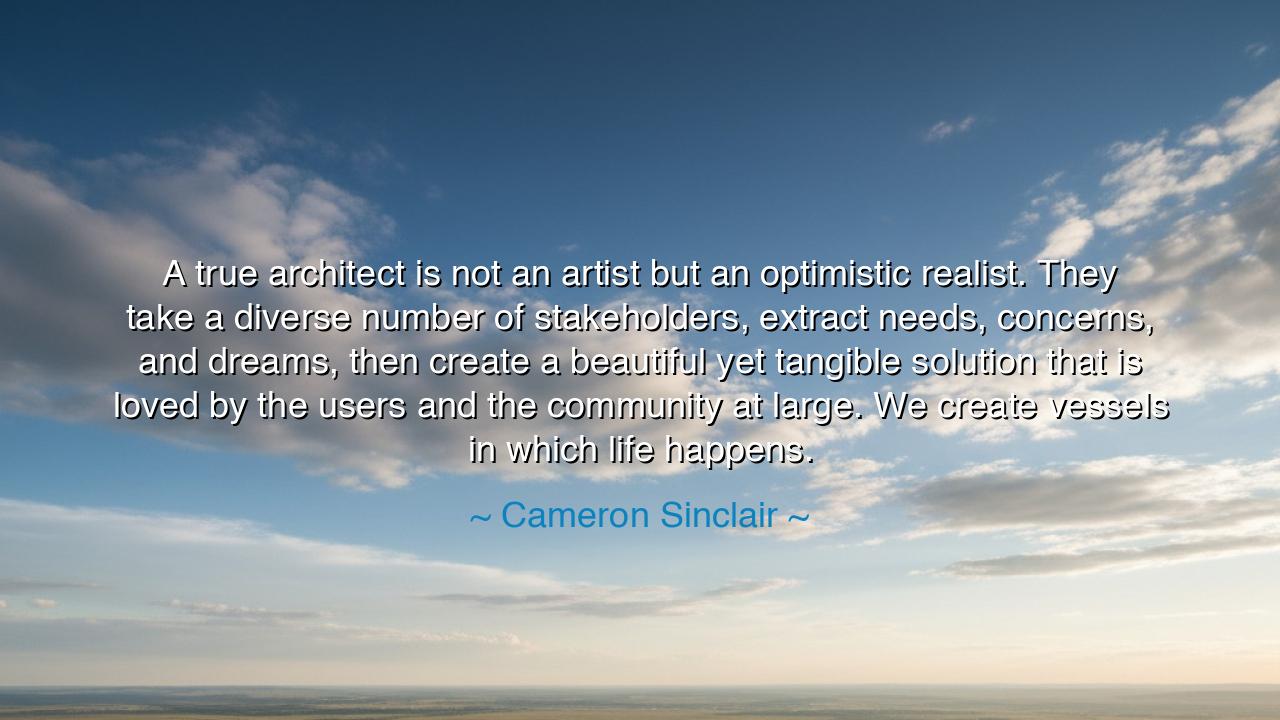
A true architect is not an artist but an optimistic realist. They
A true architect is not an artist but an optimistic realist. They take a diverse number of stakeholders, extract needs, concerns, and dreams, then create a beautiful yet tangible solution that is loved by the users and the community at large. We create vessels in which life happens.






When Cameron Sinclair, the humanitarian architect and founder of Architecture for Humanity, declared, “A true architect is not an artist but an optimistic realist. They take a diverse number of stakeholders, extract needs, concerns, and dreams, then create a beautiful yet tangible solution that is loved by the users and the community at large. We create vessels in which life happens,” he spoke not only of architecture, but of the sacred art of creation itself. His words echo the wisdom of the ancients, who saw builders not as mere craftsmen, but as shapers of existence, those who give form to human hope. To build, in his view, is to listen deeply, to understand the heart of a people, and then to craft from that understanding a space where life can unfold in beauty and dignity.
In saying that a true architect is not an artist but an optimistic realist, Sinclair honors the dual nature of the builder’s calling. The artist dreams—the architect grounds that dream in stone and steel. The artist expresses the soul—the architect builds it into reality. To be an “optimistic realist” is to stand between heaven and earth, with eyes lifted to vision and feet rooted in truth. It is to believe in the possibility of transformation while acknowledging the constraints of the world—budget, material, climate, need. The architect’s optimism gives birth to the idea; their realism ensures that the idea endures.
This harmony between dream and reality has been the hallmark of great builders throughout history. Consider Filippo Brunelleschi, the genius of Florence, who designed the dome of the Cathedral of Santa Maria del Fiore. When others said it could not be done, Brunelleschi believed—not with blind idealism, but with disciplined vision. He studied ancient Roman techniques, invented new machinery, and united artistry with mathematics to raise one of the wonders of the world. He was an optimistic realist, transforming the impossible into the inevitable. In his dome, Florence found not just a structure, but a symbol of human ingenuity—a vessel in which the spirit of a city found expression.
Sinclair’s words also speak to the moral duty of the architect—to listen, to understand, and to serve. “They take a diverse number of stakeholders, extract needs, concerns, and dreams,” he says. This is no small task. It is the act of a healer, a translator of souls. For to build well, one must first listen deeply—to the fears of the mother, the hopes of the child, the traditions of the elder, and the aspirations of the community. Out of these fragments of humanity, the architect weaves a coherent whole. Thus, the architect is not the master imposing vision upon the world, but the servant who reveals what was already yearning to be born.
The phrase, “We create vessels in which life happens,” holds the deepest wisdom of all. Every wall, every corridor, every beam of light falling through a window becomes a stage for human existence. Architecture, in its truest form, is not about the grandeur of the structure, but the life it shelters—the laughter of children in a schoolyard, the quiet prayer of an old woman in a chapel, the shared meal of a family beneath a humble roof. Sinclair reminds us that buildings are not monuments to ego, but sanctuaries for living. The architect does not merely design spaces; they shape the rhythm of human experience.
To the ancients, this truth was sacred. The builders of temples in Greece, of pyramids in Egypt, of pagodas in China—all saw their work as acts of devotion. The balance, proportion, and harmony of their structures mirrored the order of the cosmos. Sinclair, in his modern language, calls for the same reverence—for an architecture that serves humanity rather than vanity. His “vessels” are not cages of stone, but living frameworks, breathing with the people who inhabit them. In his eyes, the architect is both philosopher and craftsman, joining the seen with the unseen.
The lesson here, though addressed to architects, belongs to all who create. Whether you build houses, write stories, or nurture communities, remember this: creation is an act of service. Listen before you shape. Understand before you act. Let your work be both grounded and hopeful—strong enough to endure, yet open enough to inspire. For true creation, like true architecture, lies not in the pursuit of perfection, but in the crafting of spaces where others may thrive.
So let us remember Sinclair’s wisdom: to be a builder of life, not just a maker of things. Approach your work as an optimistic realist—see what could be, yet honor what is. Create with both heart and hand, with compassion and craft. For in the end, every noble endeavor—every bridge, song, poem, or home—is a vessel through which life itself flows. And those who build such vessels, humbly and wisely, leave behind not mere structures, but living legacies, sanctuaries for the human soul to dwell, to dream, and to endure.






AAdministratorAdministrator
Welcome, honored guests. Please leave a comment, we will respond soon